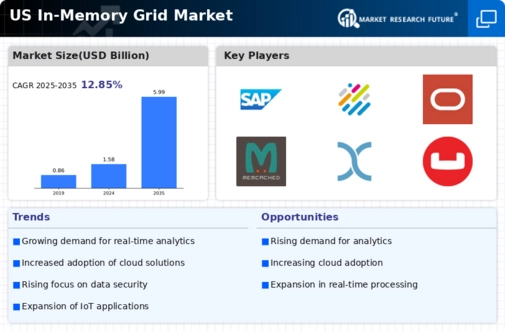Shift Towards Hybrid Cloud Environments
The shift towards hybrid cloud environments is reshaping the landscape of the in memory-grid market. Organizations are increasingly adopting hybrid models to leverage the benefits of both on-premises and cloud-based solutions. This trend allows for greater flexibility and cost efficiency, as businesses can optimize their resources based on specific needs. The in memory-grid market is adapting to this shift by providing solutions that seamlessly integrate with hybrid cloud architectures. As companies seek to enhance their operational agility, the demand for in memory-grid solutions that support hybrid environments is expected to grow, potentially contributing to a market expansion of 18% by 2027.
Growing Demand for High-Speed Data Processing
The in memory-grid market is experiencing a surge in demand for high-speed data processing capabilities. Organizations are increasingly reliant on real-time data analytics to drive decision-making processes. This trend is particularly evident in sectors such as finance and e-commerce, where the ability to process large volumes of data swiftly can lead to competitive advantages. According to recent estimates, the in memory-grid market is projected to grow at a CAGR of approximately 20% over the next five years, driven by the need for faster data retrieval and processing. As businesses continue to prioritize efficiency, the in memory-grid market is likely to see substantial investments in technologies that enhance data processing speeds.
Enhanced Focus on Data Security and Compliance
Data security and compliance are paramount concerns for organizations operating within the in memory-grid market. With increasing regulatory requirements, businesses are compelled to adopt solutions that not only enhance data processing capabilities but also ensure robust security measures. The in memory-grid market is evolving to incorporate advanced security features, such as encryption and access controls, to address these challenges. As organizations strive to protect sensitive information, the demand for secure in memory-grid solutions is likely to rise. This focus on security could drive a notable increase in market investments, with projections indicating a potential growth of 15% in the security segment of the in memory-grid market by 2026.
Rising Need for Scalability in IT Infrastructure
In the in memory-grid market, the need for scalable IT infrastructure is becoming increasingly critical. As organizations expand their operations, they require solutions that can seamlessly scale to accommodate growing data volumes. This demand is particularly pronounced in industries such as healthcare and telecommunications, where data generation is exponential. The in memory-grid market is responding to this need by offering solutions that allow for dynamic scaling, enabling businesses to adjust their resources according to demand. Market analysts suggest that the scalability feature could account for a significant portion of the in memory-grid market's growth, potentially reaching a valuation of $5 billion by 2027.
Integration of Internet of Things (IoT) Technologies
The integration of Internet of Things (IoT) technologies is significantly influencing the in memory-grid market. As IoT devices proliferate, the volume of data generated is escalating, necessitating efficient data management solutions. In memory-grid systems are well-suited to handle the high throughput and low latency requirements associated with IoT applications. This trend is particularly relevant in smart cities and industrial automation, where real-time data processing is essential. Analysts predict that the in memory-grid market could see a substantial uptick in demand as IoT adoption continues to rise, potentially leading to a market size increase of $3 billion by 2028.

















Leave a Comment